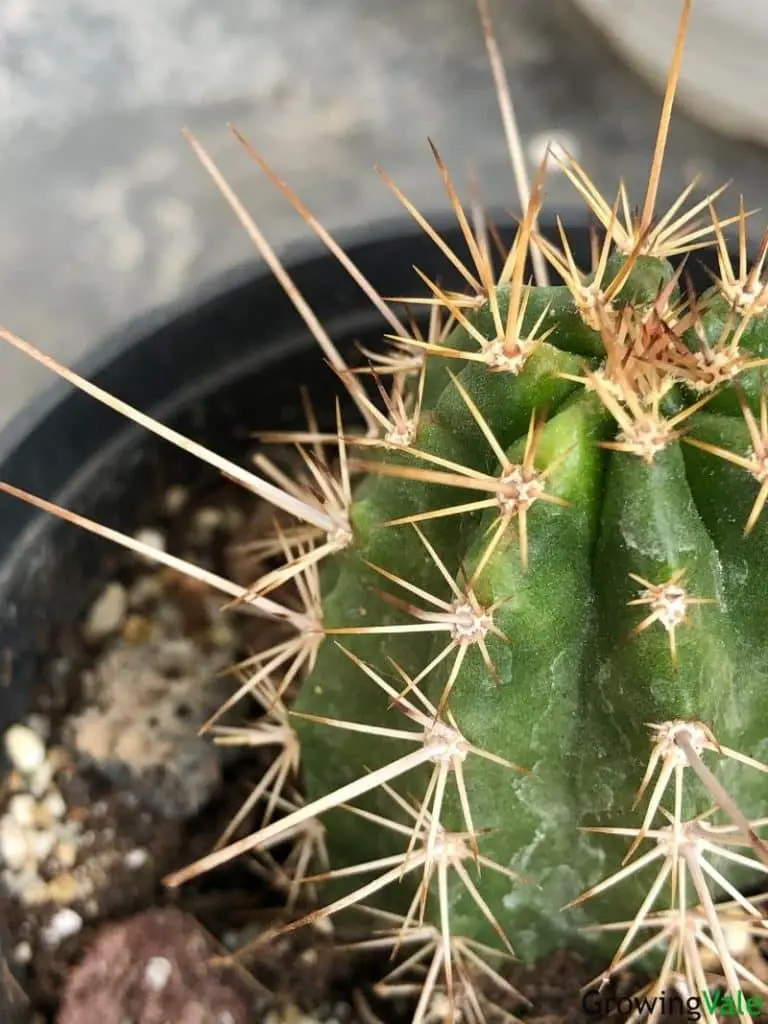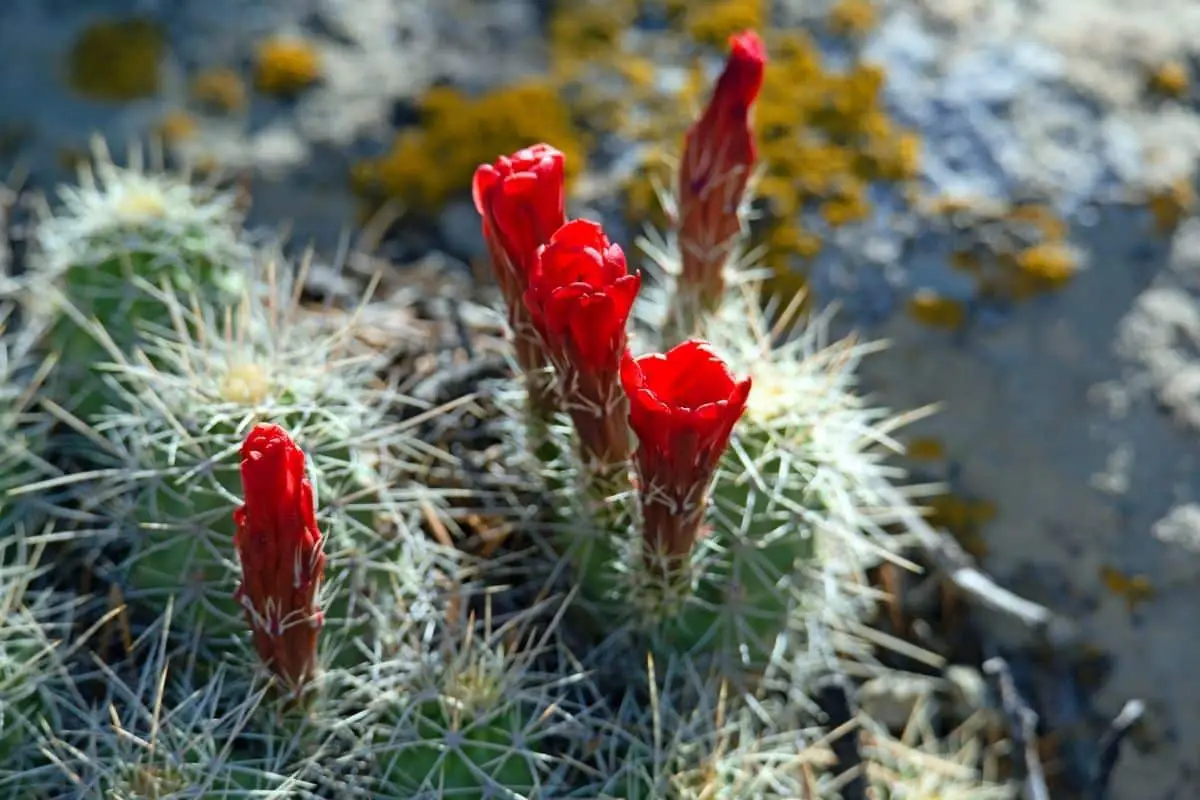Few things are as visually stunning as the sight of a flowering claret cup cactus in the Mojave Desert in California. Imagine stepping over a rocky outcrop and before you is a sea of orangy-red flowers opening their bright faces to the sun.
These plants are low-growing and only reach a height of about 1 foot. However, this is a readily spreading plant and mounds can reach a width of 3 to 4 feet. The cactus is also highly variable in that some plants will be heavily spined while others will have none.
The flowers on this cactus are truly spectacular and contain thick nectar that is attractive to hummingbirds in particular. After flowering, the plant produces edible, juicy fruits. These can range in color from green to pink and sometimes red. Animals that live in desert regions are particularly fond of these fruits.
This is one of the easiest cacti to grow and thrives in hot conditions with very little water. It’s ideal for planting in rock gardens and desert areas and also does well if grown in a pot. Especially, if it has room to spread.
History
The scientific name of this cactus comes from the Greek word “echinos” which means hedgehog while “triglochidiatus” means “three barbed bristles” and refers to the spines on this cactus.
Interestingly, native Americans would collect this cactus from the desert and burn off the spines. They would then mash the stems, add some sugar to the mixture and bake it as a sweet cake.
This plant is also the Colorado State cactus.
Plant Facts
| Scientific name | Echinocereus triglochidiatus |
| Common names | Claret cup cactus, Hedgehog cactus, Kingcup cactus, Mojave Mound cactus |
| Genus | Echinocereus |
| Family | Cactaceae |
| Height | 1 foot |
| Width | 3 to 4 feet spread |
| USDA Plant Hardiness Zone | 7a to 10b |
| Origin | Southwestern United States |
| Flower colors | Red & orange |
| Blooming season | April to June |
| Plant/Flower special features | This cactus will flower more abundantly if it’s been exposed to cool, dry winters. |
How to Plant and Grow Claret Cup Cacti
This plant can either be grown outdoors if you live in a mild climate zone or indoors if your winters get too cold. Although this plant is fairly cold-tolerant, it does need warmth to grow.
When selecting a pot for your cactus, make sure that it has large drainage holes so any excess moisture can drain away quickly after watering. This species is ideal for growing in a large, shallow container to give it room to spread.
How to Propagate Claret Cup Cactus
One of the easiest ways to propagate this plant is by using plantlets that you’ve removed from the mother plant. Be very gentle when you do this because this cactus has quite a shallow and weak root system. Also, remember to wear gloves to avoid those sharp spines getting stuck in your fingers.
To do this, grab a pair of kitchen tongs and carefully separate one or more offsets from the main plant. Leave this in a cool, dry spot for a few days until you see a callus form. Once the offset has callused, plant it in a pot with some cactus mix and water it thoroughly.
Continue to water once a week for the first month or until roots have developed. Then, water the plant once every 2 to 3 weeks until it’s well established. Make sure that the pot you’re using has good drainage holes so that the excess water can drain away easily.
The plant can also be propagated from seeds but this is an extremely slow way to grow this cactus because it won’t start flowering until it’s about 5 years old.

Care and Maintenance
Claret cup cactus requires minimal maintenance once it’s established. It should only be watered in the warmer months when the top 2 – 3 inches of the soil are dry. Giving the plant some fertilizer in the summer months will encourage more flowers to form.
Soil
Like all cacti, this cactus needs very well-drained soil. If growing outdoors, choose loose sandy soil and add a layer of pea-sized gravel around the base of the plant to aid drainage.
If you’re growing your cactus in a pot, choose a proprietary cactus mix that is loose and free-draining. It should contain a large proportion of grit to keep the cactus roots happy.
Water
This cactus does not require a lot of water except for when it’s first getting established. If growing outdoors, water well after planting and then add water once a week for about the first month. After that, reduce the watering to once every 2 to 4 weeks in the spring and summer.
Stop giving your plant water in early fall. This will allow the cactus to prepare for winter. Do not water the plant again until early spring.
If you’re growing your plant indoors in a pot, you should only have to water the plant once every 2 to 3 weeks during the warmer months and hold back the water once the weather gets colder.
Just remember that cacti don’t like sitting in water or else their roots will rot. If you have a saucer or tray under your pot, make sure that you empty it completely after the pot has fully drained.
Fertilizer
The claret cup cactus will benefit from a liquid fertilizer applied once a month during the warmer weather. Do not fertilize this cactus during the winter as it is dormant in colder weather.
Sunlight
This cactus prefers to grow in full sun. If you live in a cool area and want to plant your hedgehog cactus outdoors, choose a spot that is near a south or west-facing wall as this will provide protection during the colder weather.
If you’re growing your hedgehog cactus indoors, then place it near a south or west-facing window where it will get plenty of sunlight. For young plants, try to provide some protection from the scorching afternoon sun.
Temperature and Humidity
This cactus really does like the heat but it is also relatively cold tolerant as long as it’s not exposed to frost. In fact, exposing the cactus to cooler temperatures in winter will ensure that you get plenty of flowers in the warmer months.
Pruning
This cactus can be pruned to remove dead or damaged stems and to maintain a nice shape. After pruning, use any healthy offsets that you’ve removed to propagate new plants. This not only allows you to grow your collection but also gives you some spare plants to give away.
Pest and diseases
In general, this plant should not have any pest or disease problems. If you’re growing it indoors, you might see some mealybugs or scale insects on your plant. If this happens, just dab the offending insects with a cotton swab dipped in a diluted solution of isopropyl alcohol.
Uses of Claret Cup Cactus
The flowers of this plant are extremely attractive to hummingbirds as they contain an abundance of sweet nectar. Plus, hummingbirds are also very attracted to the color red.
The plant also produces rounded fruits that are about one inch long. The outside skin of the fruit has spines but once picked, these will fall off or can be carefully rubbed off. The fruit can then be cut open and the juicy white pulp can be eaten after removing the black seeds.
Common Varieties and Cultivars of Echinocereus triglochidiatus
There are a number of subspecies and cultivated varieties of the claret cup cactus. These echinocereus triglochidiatus varieties include:
- Echinocereus triglochidiatus var. inermis
- Echinocereus triglochidiatus var. inermis f. cristata
- Echinocereus triglochidiatus var. mojavensis
- Echinocereus triglochidiatus var. mojavensis f. inermis
- Echinocereus triglochidiatus var. octacanthus
- Echinocereus triglochidiatus f. variegatus
Conclusion
The claret cup cactus is one of the easiest Echinocereus cacti to grow. It’s the Colorado State cactus and is prized for its gorgeous cup-shaped flowers that are prolific in the summer months. The flowers are a bright reddish-orange and grow from the crown of the plant.
This cactus requires very little maintenance once it’s established and is extremely drought tolerant and enjoys growing in full sun. It only needs to be watered when the soil is completely dry but does benefit from some extra fertilizer in the warmer months.
*image by nawwal.life/depositphotos
*References
Reference list:
https://www.fs.fed.us/wildflowers/plant-of-the-week/echinocereus_triglochidiatus.shtml
”Close”

